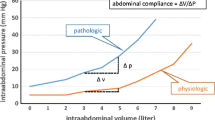Abstract
Background
Abdominal compartment syndrome (ACS) is a diffucult entity with two main problems during its course: (1) survival of the patient during the early period and (2) closure of the open wounds during the late period. In this study we evaluated the decision to decompress according to the level of intraabdominal pressure (IAP) and analysis of any recurrent or persistent increase in IAP.
Methods
A prospective study was undertaken on 119 patients with increased IAP. The IAP was measured daily by obtaining the bladder pressure. Patients were monitored via a central venous line; and vital signs, arterial blood gases, the Acute Physiology, Age, and Chronic Health Evaluation II (APACHE II) score, and abbreviated mental tests were recorded. The suggestions of Meldrum et al. were taken as a guideline during the treatment. The sensitivity and specifity of IAP and APACHE II scores for different cutoff values were calculated using the receiver operating characteristic curve.
Results
Hospital mortality was 33.6%, which increased with co-morbidities (p = 0.03). A cutoff value for IAP of 23 mmHg was considered an optimal point predicting mortality. The IAP within the first 3 days for patients who died was higher than the cutoff value. For patients with IAP of 15 to 25 mmHg, nonsurgical therapy increased the rate of mortality (odds ratio 5.2, 95% confidence interval 1.0–27.7; p = 0.03).
Conclusions
In patients with ACS emergency, it is recommended that decompressive laparotomy to be performed even if the IAP falls below 25 mmHg. For patients with IAP levels higher than 25 mmHg, the IAP should be meticolusly brought below the cutoff level during the postoperative period.



Similar content being viewed by others
References
Walker J, Criddle LM (2003) Pathophysiology and management of abdominal compartment syndrome. Am J Crit Care 12:367–371
Bailey J, Shapiro MJ (2000) Abdominal compartment syndrome. Crit Care 4:23–29
Hunter JD, Damani Z (2004) Intra-abdominal hypertension and the abdominal compartment syndrome. Anaesthesia 59:899–907
Vegar-Brozovic V, Stoic-Brezak J (2006) Pathophysiology of abdominal compartment syndrome. Transplant Proc 38:833–835
Kouraklis G, Spirakos S, Glinavou A (2002) Damage control surgery: an alternative approach for the management of critically injured patients. Surg Today 32:195–202
Nagappan R, Ernest D, Whitfield A (2005) Recognition and management of intra-abdominal hypertension and abdominal compartment syndrome. Crit Care Resusc 7:298–302
Tiwari A, Myint F, Hamilton G (2006) Recognition and management of abdominal compartment syndrome in the United Kingdom. Intensive Care Med 32:906–909
De Waele JJ, Hoste EA, Malbrain ML (2006) Decompressive laparotomy for abdominal compartment syndrome—a critical analysis. Crit Care 10:R51
Moore EE, Burch JM, Franciose RJ, et al. (1998) Staged physiologic restoration and damage control surgery. World J Surg 22:1184–1190; discussion 1190–1191
Kron IL, Harman PK, Nolan SP (1984) The measurement of intra-abdominal pressure as a criterion for abdominal re-exploration. Ann Surg 199:28–30
Burch JM, Moore EE, Moore FA, et al. (1996) The abdominal compartment syndrome. Surg Clin North Am 76:833–842
Qureshi KN, Hodkinson HM (1974) Evaluation of a ten-question mental test in the institutionalized elderly. Age Ageing 3:152–157
Malbrain ML, Cheatham ML, Kirkpatrick A, et al. (2006) Results from the International Conference of Experts on Intra-abdominal Hypertension and Abdominal Compartment Syndrome. I. Definitions. Intensive Care Med 32:1722–1732
Meldrum DR, Moore FA, Moore EE, et al. (1997) Prospective characterization and selective management of the abdominal compartment syndrome. Am J Surg 174:667–672
Crandall M, West MA (2006) Evaluation of the abdomen in the critically ill patient: opening the black box. Curr Opin Crit Care 12:333–339
Rotando M (1999) Treatment and sequelae of abdominal compartment syndrome: early and later management of the open abdomen. In: Program and abstracts of the 85th Annual Clinical Congress of the American College of Surgeons, San Francisco
Hobson KG, Young KM, Ciraulo A, et al. (2002) Release of abdominal compartment syndrome improves survival in patients with burn injury. J Trauma 53:1129–1133
Mcnelis J, Soffer S, Marini CP, et al. (2002) Abdominal compartment syndrome in the surgical intensive care unit. Am Surg 68:18–23
Ertel W, Oberholzer A, Platz A, et al. (2000) Incidence and clinical pattern of the abdominal compartment syndrome after “damage-control” laparotomy in 311 patients with severe abdominal and/or pelvic trauma. Crit Care Med 28:1747–1753
Eddy V, Nunn C, Morris JA Jr (1997) Abdominal compartment syndrome: the Nashville experience. Surg Clin North Am 77:801–812
Ridings PC, Bloomfield GL, Blocher CR (1995) Cardiopulmonary effects of raised intra-abdominal pressure before and after intravascular volume expansion. J Trauma 39:1071–1078
Gracias VH, Braslow B, Johnson J, et al. (2002) Abdominal compartment syndrome in the open abdomen. Arch Surg 137:1298–1300
Ivatury RR, Porter JM, Simon RJ, et al. (1998) Intra-abdominal hypertension after life-threatening penetrating abdominal trauma: prophylaxis, incidence, and clinical relevance of gastric mucosal pH and abdominal compartment syndrome. J Trauma 44:1016–1021
Author information
Authors and Affiliations
Corresponding author
Rights and permissions
About this article
Cite this article
Parsak, C.K., Seydaoglu, G., Sakman, G. et al. Abdominal Compartment Syndrome: Current Problems and New Strategies. World J Surg 32, 13–19 (2008). https://doi.org/10.1007/s00268-007-9286-x
Published:
Issue Date:
DOI: https://doi.org/10.1007/s00268-007-9286-x




